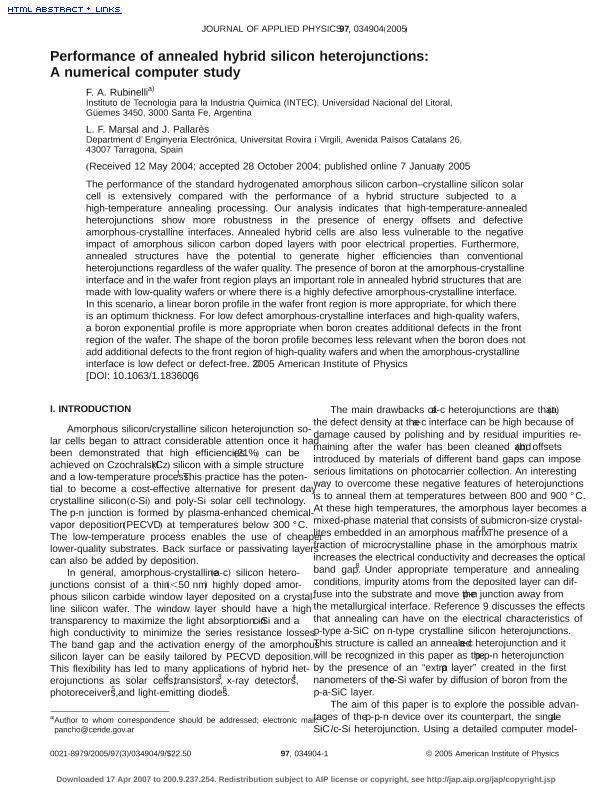Mostrar el registro sencillo del ítem
dc.contributor.author
Rubinelli, Francisco Alberto

dc.contributor.author
Marsal, L. F.
dc.contributor.author
Pallarès, J.
dc.date.available
2017-09-04T19:10:11Z
dc.date.issued
2005-01
dc.identifier.citation
Rubinelli, Francisco Alberto; Marsal, L. F.; Pallarès, J.; Performance of annealed hybride silicon heterojunctions: a numerical computer study; American Institute of Physics; Journal of Applied Physics; 97; 3; 1-2005; 34904-34913
dc.identifier.issn
0021-8979
dc.identifier.uri
http://hdl.handle.net/11336/23586
dc.description.abstract
The performance of the standard hydrogenated amorphous silicon carbon–crystalline silicon solar cell is extensively compared with the performance of a hybrid structure subjected to a high-temperature annealing processing. Our analysis indicates that high-temperature-annealed heterojunctions show more robustness in the presence of energy offsets and defective amorphous-crystalline interfaces. Annealed hybrid cells are also less vulnerable to the negative impact of amorphous silicon carbon doped layers with poor electrical properties. Furthermore, annealed structures have the potential to generate higher efficiencies than conventional heterojunctions regardless of the wafer quality. The presence of boron at the amorphous-crystalline interface and in the wafer front region plays an important role in annealed hybrid structures that are made with low-quality wafers or where there is a highly defective amorphous-crystalline interface. In this scenario, a linear boron profile in the wafer front region is more appropriate, for which there is an optimum thickness. For low defect amorphous-crystalline interfaces and high-quality wafers, a boron exponential profile is more appropriate when boron creates additional defects in the front region of the wafer. The shape of the boron profile becomes less relevant when the boron does not add additional defects to the front region of high-quality wafers and when the amorphous-crystalline interface is low defect or defect-free.
dc.format
application/pdf
dc.language.iso
eng
dc.publisher
American Institute of Physics

dc.rights
info:eu-repo/semantics/openAccess
dc.rights.uri
https://creativecommons.org/licenses/by-nc-sa/2.5/ar/
dc.subject
Hybride Solar Cells
dc.subject
Amorphous Silicon
dc.subject
Crystalline Silicon
dc.subject
Annealing
dc.subject.classification
Ingeniería de Sistemas y Comunicaciones

dc.subject.classification
Ingeniería Eléctrica, Ingeniería Electrónica e Ingeniería de la Información

dc.subject.classification
INGENIERÍAS Y TECNOLOGÍAS

dc.title
Performance of annealed hybride silicon heterojunctions: a numerical computer study
dc.type
info:eu-repo/semantics/article
dc.type
info:ar-repo/semantics/artículo
dc.type
info:eu-repo/semantics/publishedVersion
dc.date.updated
2017-08-24T18:55:40Z
dc.journal.volume
97
dc.journal.number
3
dc.journal.pagination
34904-34913
dc.journal.pais
Estados Unidos

dc.journal.ciudad
Newsville
dc.description.fil
Fil: Rubinelli, Francisco Alberto. Consejo Nacional de Investigaciones Científicas y Técnicas. Centro Científico Tecnológico Conicet - Santa Fe. Instituto de Desarrollo Tecnológico para la Industria Química. Universidad Nacional del Litoral. Instituto de Desarrollo Tecnológico para la Industria Química; Argentina
dc.description.fil
Fil: Marsal, L. F.. Universitat Rovira I Virgili; España
dc.description.fil
Fil: Pallarès, J.. Universitat Rovira I Virgili; España
dc.journal.title
Journal of Applied Physics

dc.relation.alternativeid
info:eu-repo/semantics/altIdentifier/doi/http://dx.doi.org/10.1063/1.1836006
dc.relation.alternativeid
info:eu-repo/semantics/altIdentifier/url/http://aip.scitation.org/doi/10.1063/1.1836006
Archivos asociados
